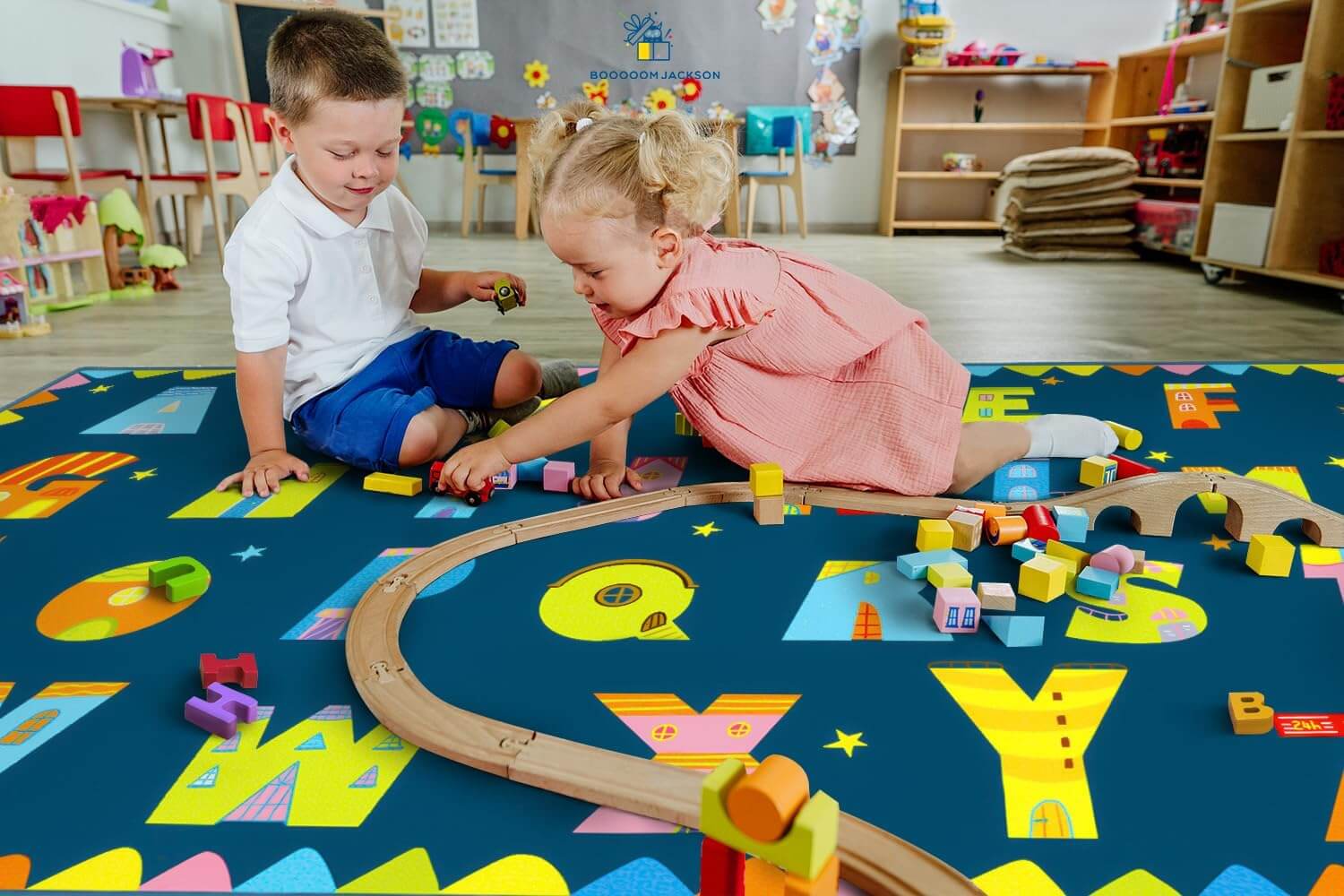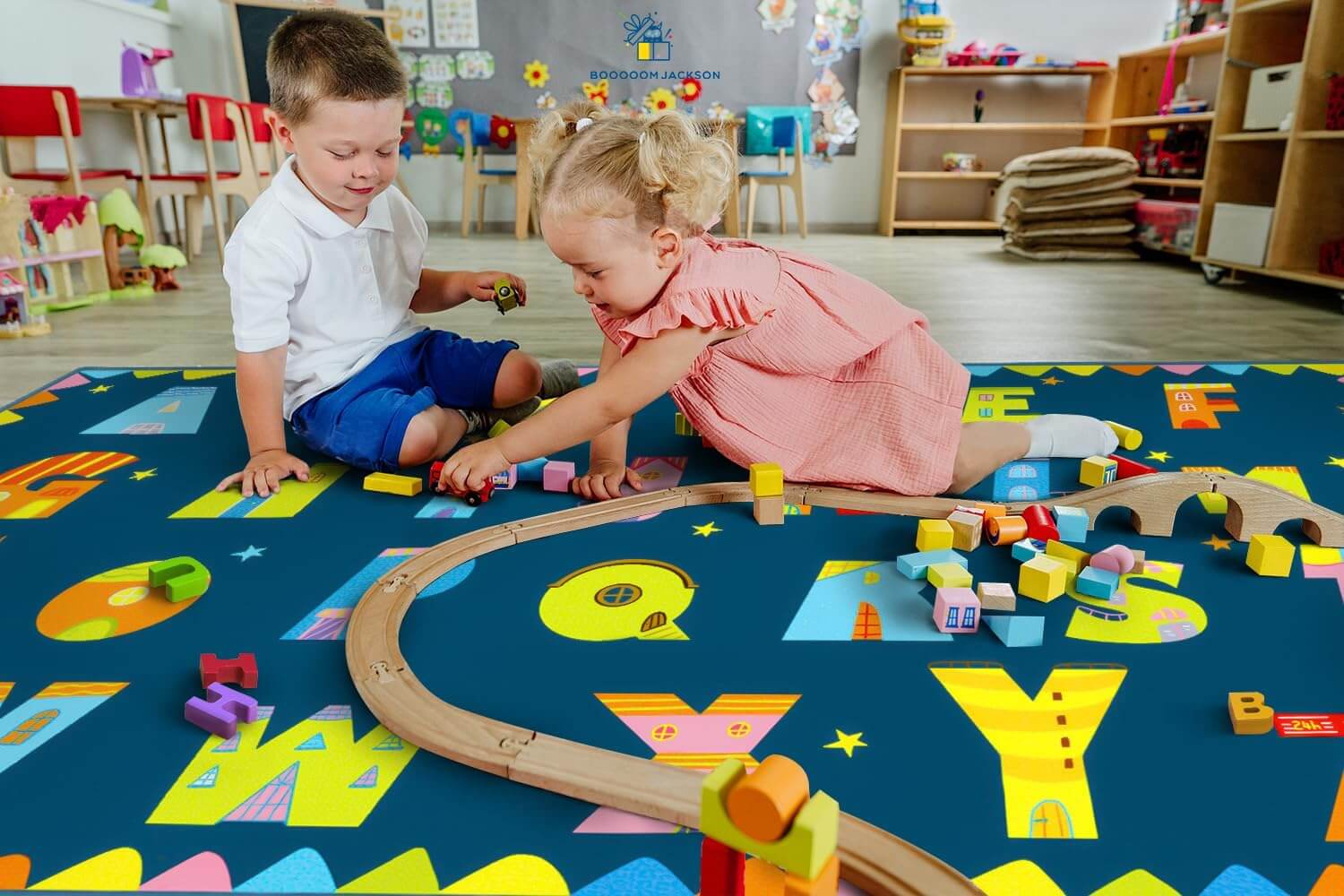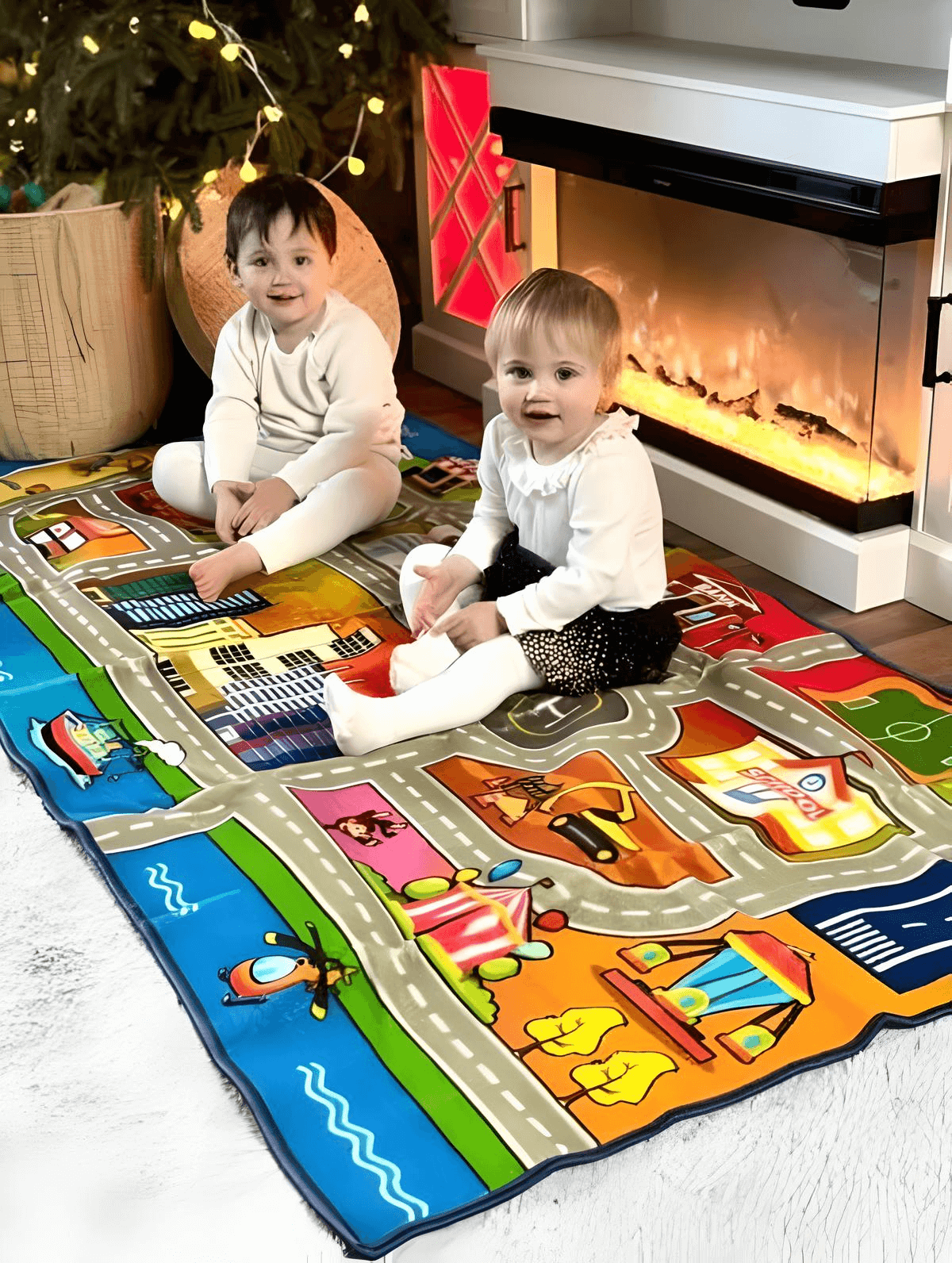Y'all ever tried to fit 25 wiggly first-graders onto a postage stamp-sized classroom rug? Or maybe you've gone the other route and ordered a carpet so massive it swallowed half your classroom whole, leaving precious little room for those centers you spent all summer planning?
Finding that "just right" classroom carpet size is like the educational version of Goldilocks—too small and you've got kiddos practically sitting in each other's laps (hello, conflict management lessons!). Too large and suddenly your beautiful classroom design looks like a carpet store showroom!
At BooooomJackson, we've helped thousands of teachers find their perfect classroom carpet fit. Let's roll out some practical wisdom about selecting the ideal dimensions for your learning space!
The Science of Classroom Square Footage
Before we dive into specific measurements, let's talk about some space planning fundamentals. According to educational environment research, students need a minimum personal bubble to feel comfortable and engage effectively in learning.
The experts at We Are Teachers recommend allowing:
- 12-18 square feet per child for primary grades
- 10-15 square feet per child for intermediate grades
- 8-12 square feet per child for upper elementary/middle grades
"When I first started teaching, I crammed all 22 kindergartners onto a 6' x 8' rug because that's what my budget allowed," confesses Ms. Rodriguez from Sunshine Elementary. "It was basically a daily mosh pit of tiny humans. Once we upgraded to a properly sized 9' x 12', our whole classroom culture changed—fewer conflicts, better attention spans, and I stopped losing my voice from constantly redirecting personal space issues!"
Right-Sizing by Activity: Different Functions Need Different Dimensions
One size definitely does not fit all when it comes to classroom rugs. The perfect dimensions depend largely on what learning activities will happen in that space:
Whether you're choosing a classroom carpet, instructional rug, or a versatile classroom area rug, the intended use should always guide the size.
Whole-Class Gathering Spot
If your carpet will serve as home base for morning meetings, read-alouds, and whole-class instruction, you'll need substantial square footage:
- For 15-20 students (K-2): Minimum 8' x 10'
- For 20-25 students (K-2): Minimum 9' x 12'
- For 25-30 students (K-2): Consider 10' x 14' or larger
- For older students (3-5): You can reduce these dimensions by about 15% (they have longer legs but smaller personal space needs)
As veteran third-grade teacher Mr. Washington points out: "Personal space requirements change dramatically between fall and spring. My August third-graders need clear boundaries and plenty of room, but by May, they've developed those invisible force fields that let them sit knee-to-knee without constant 'he's touching me!' incidents."
Small Group Instruction Area
For guided reading, math groups, or intervention circles:
- For 4-6 students: A 5' x 7' or 6' round carpet works beautifully
- For 6-8 students: Consider a 6' x 9' or 7' round
- For 8-10 students: Look for 8' x 8' or 8' round options
"My reading group carpet is intentionally sized for exactly 8 students," shares literacy specialist Ms. Chen. "When I occasionally try to squeeze in a ninth, the crowding creates such distraction that comprehension suffers.
Properly sized small group spaces aren't just about comfort—they directly impact learning outcomes!"
The right learning rug can foster focus, minimize distractions, and create a defined instructional zone that feels intentional and inviting.
Learning Centers or Station Areas
For designated learning zones within your classroom:
- Individual work centers: 4' x 6' provides enough space for 2-3 students
- Partner work areas: 5' x 7' accommodates 4-6 students comfortably
- Maker spaces: Allow extra room—at least 6' x 8' for 4-5 students with materials
Second-grade teacher Mr. Patel explains his multi-rug approach: "Instead of one massive carpet, I have five 4' x 6' rugs defining different learning zones. This 'carpet archipelago' creates natural traffic patterns and gives each activity its own distinct space."
Shape Considerations: Beyond Just Square Footage
While calculating square footage is essential, the shape of your carpet significantly impacts its functionality:
Rectangular Rugs
The classic choice offers:
- Maximum seating capacity for standard classroom arrangements
- Clear front/back orientation for directed instruction
- Efficient use of typically rectangular classroom spaces
Best for: Whole group instruction, traditional seating arrangements
Round Rugs
These inclusive circles provide:
- No hierarchical "front" position—everyone's equal in the circle
- Natural facilitation of discussion and sharing
- Elimination of "back row" behavior issues
Best for: Morning meetings, community building, discussions
According to responsive classroom experts, circular seating arrangements significantly increase equitable participation and eye contact during class discussions.
Irregular Shapes
Some classrooms benefit from:
- Kidney shapes that allow teachers to sit inside the curve
- Puzzle-piece shapes that can be reconfigured
- Modular carpet tiles that adapt to changing needs
Best for: Flexible learning environments, specialized instruction
Some teachers also prefer oval rugs or square rugs to fit unique classroom corners or create cozy reading nooks.
These shapes can work especially well in library areas or quiet zones where space is limited.
Room Proportion Mathematics: The Golden Ratio of Rugs to Rooms
The perfect carpet doesn't just accommodate your students—it needs to work with your overall classroom proportions. Environmental design principles suggest:
- Ideal carpet-to-floor ratio: Your main carpet should cover approximately 25-35% of usable floor space
- Circulation paths: Maintain at least 30" clearance around carpet edges
- Furniture integration: Consider whether furniture legs will rest on or off the carpet
"When I upgraded classrooms last year, I made the classic rookie mistake," admits fifth-grade teacher Ms. Taylor. "
I measured my empty room in June and ordered a carpet that filled the space beautifully.
Then August came, I arranged all my furniture, and suddenly my 'perfect' carpet was overwhelming the space.
I wish I'd followed the one-third rule!"
The Multi-Carpet Strategy: When One Size Can't Do It All
Many teachers find that a single all-purpose carpet simply can't meet all their instructional needs. The flexible classroom movement advocates for multiple defined spaces:
The Multi-Zone Approach:
- Main gathering carpet (largest dimension)
- Small group instruction rug
- Reflection/quiet space carpet
- Collaborative work rug
"Our classroom has four BooooomJackson carpets in different sizes," explains innovative first-grade teacher Ms. Jackson. "We've got an 8' x 10' main meeting area, two 5' roundies for small groups, and a cozy 4' x 6' in our library nook. Each space has its own purpose, rules, and voice level expectations."
Real-World Sizing Scenarios
Let's walk through some common classroom configurations and their ideal carpet dimensions:
Scenario 1: Standard 24' x 36' Elementary Classroom
- Main carpet: 9' x 12' (accommodates whole class while maintaining other zones)
- Placement: Offset from center, typically near main instructional area
- Surrounding space: Allows for desk clusters, centers, and traffic flow
Scenario 2: Compact 20' x 24' Classroom
- Main carpet: 8' x 10' (balances student needs with spatial constraints)
- Placement: Consider diagonal orientation to maximize perceived space
- Multi-carpet option: 6' x 9' main carpet plus 6' round for small groups
Scenario 3: Open Concept Modern Learning Space
- Flexible carpet tiles: Create configurable spaces that change with needs
- Multiple defined zones: Several medium carpets rather than one giant one
- Traffic consideration: Clear pathways between carpet islands
Practical Measurement Tips Before You Buy
Before clicking that "order" button on your dream classroom carpet, try these practical steps:
Newspaper Mapping
Use newspaper to create a full-size template on your classroom floor. This allows you to visualize the carpet in relation to your furniture and test traffic patterns.
Masking Tape Outlines
Use tape to mark carpet dimensions on your floor. Have students sit within the taped area to ensure comfortable fit before purchasing.
Student Size Considerations
Remember that kindergarteners and fifth graders have dramatically different space needs. If you teach primary grades, sit on the floor yourself to get a feel for appropriate dimensions!
First-grade teacher Mr. Thompson shares his wisdom: "I always place my students in the taped outline and take a picture from above. This bird's eye view shows crowding issues that aren't obvious from teacher height!"
Budget-Conscious Sizing Strategies
When your carpet dreams exceed your classroom budget:
The Layered Look
Place a smaller special occasion carpet atop basic large area carpet for a layered, cost-effective solution.
The Growing Collection
Start with one right-sized carpet for your most critical function, then add complementary pieces as budget allows.
The DIY Definition
Use budget-friendly carpet tiles to create custom dimensions perfectly tailored to your space.
As practical Ms. Rodriguez advises: "Don't stretch your budget for that extra two feet if it means sacrificing quality. A slightly smaller, more durable carpet will serve you better in the long run than a huge, cheap one that falls apart after one year of classroom use!"
Size Selection Checklist: Your Final Measurement Guide
Ready to find your perfect carpet fit? Use this checklist:
✓ Count your students and calculate minimum square footage needed
✓ Measure your available floor space and determine ideal carpet-to-room ratio
✓ List all planned activities that will happen on the carpet
✓ Consider student age and size at beginning and end of school year
✓ Map furniture placement and traffic flow
✓ Test mock dimensions using newspaper or tape
✓ Compare options at BooooomJackson to find the perfect fit!
Ready to roll out the perfect fit? Browse our collection of classroom rugs now and discover the right size for your students and space!
Remember, the right-sized classroom carpet isn't just about aesthetics—it's about creating a functional, comfortable learning space where students can focus on what matters: learning, connecting, and growing together.
Because when it comes to classroom carpets, size doesn't just matter—it transforms the entire learning experience!




Leave a comment
This site is protected by hCaptcha and the hCaptcha Privacy Policy and Terms of Service apply.